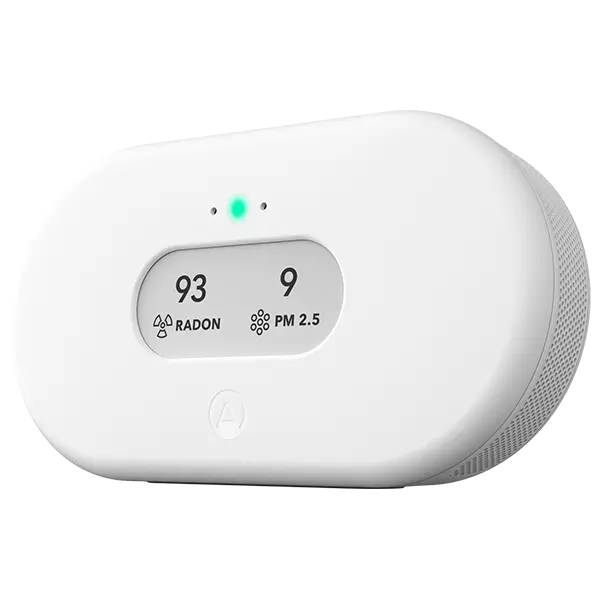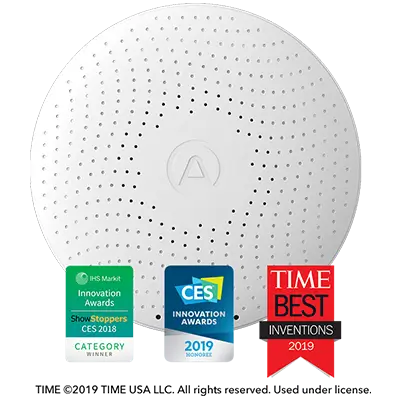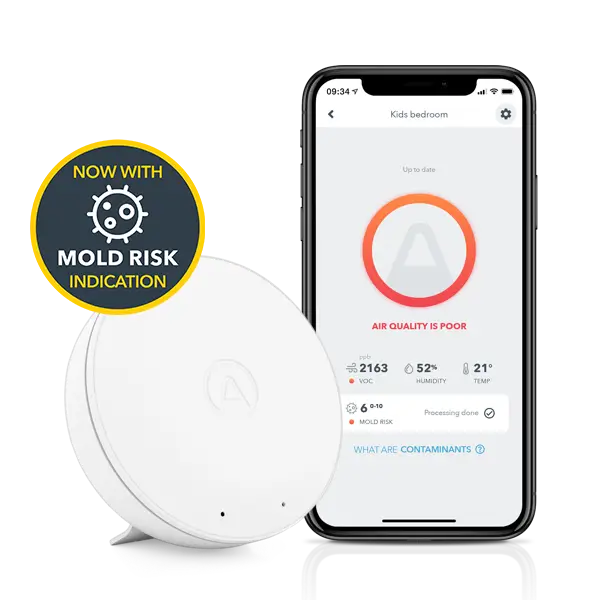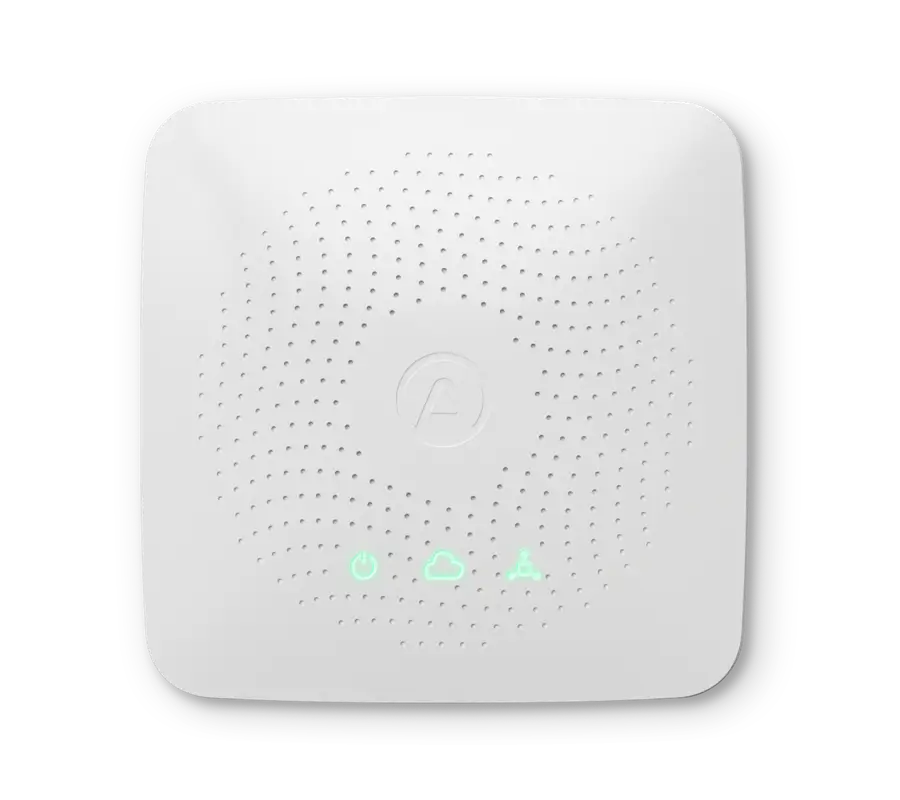How Accurate are Airthings Radon Detectors Compared to Charcoal Test Kits? We often get questions about the accuracy of Charcoal versus Digital. Here is a quick summary of our response:
Charcoal:Results are vulnerable to environmental elements, the tests are prone to user error, and they provide no visibility into fluctuations. Radon labs who handle the tests have no regulatory oversight and studies show that commercial laboratories are prone to errors.
Airthings Digital Detectors:Vigorously tested before going to market using an industry-standard Alphaguard Professional monitor as a reference device. Detectors show how levels fluctuate over time. The company is open about the error rates and accuracy for each product. It is easier to notice if there is a measurement error due to the instant and continuous readings.
Do not use charcoal as a “truth” or reference with which to compare an Airthings monitor to get a feel for accuracy. Charcoal tests will often show wrong radon levels.
Overview
There are two ways to test for radon levels: passive and active monitors. Charcoal test kits passively monitor levels of radon. These kits are placed in an area to be tested for a pre-determined period of time, anywhere from 48 hours to 3 months. The kits contain a canister with charcoal, an extremely absorbent material because it’s made from carbon, a reactive element. Radon gas will react with the charcoal, and once the test is completed, the canister is sent to a lab to analyze the results.
Constant, or active monitors, have a power source which measures the alpha decay of two isotopes of radon. Because Airthings radon detectors constantly monitor, they’re considered “active”. These detectors give a reading of the amount of radon in the air without having to be sent away.
How to Determine Accuracy
First, it’s important to understand that because radon is a gas, it’s very dynamic. Radon levels can fluctuate at the drop of a hat. There are a variety of things that can affect the concentration of the gas, including weather and seasonal changes.
In a 2009 study by the Canadian National Collaborating Centre for Environmental Health (NCCEH), they researched the effectiveness of various indoor radon testing methods. It offered great insights into the fluctuation.
“Diurnal patterns in outdoor and indoor radon levels also occur and are largely attributed to temperature and negative pressure changes within a dwelling. It is not unusual for radon levels to fluctuate by a factor of 2-3 over a 24-hour period.
Accuracy and precision are not synonymous. Precision is the closeness of two measurements to each other. For example, if you weigh something six separate times and get 7.3 grams each time, you have a very precise measurement. Accuracy, on the other hand, is the closeness of a measured value to a known or standard value. So if one item was measured at 7.3 grams each time, but actually weighed 10.8 grams, it would be a very precise, but an inaccurate measurement. So, accuracy is of the utmost importance. If you’re a more visual person, check out this video about precision and accuracy:
In the case of radon detectors, the reference device used as the “truth of truths” when it comes to measuring radon levels is an expensive AlphaGuard professional radon detector. This device is a professional-grade monitor, known for its extreme accuracy. Most new devices on the market are tested against the results of the AlphaGuard. If a charcoal canister tests an area at 140 Bq/m3(Becquerels/meter), and an AlphaGuard test spits out results of 180 Bq/m3, the charcoal kit results are most likely inaccurate.
Are Charcoal Test Kit Results Reliable?
Charcoal test kits are vulnerable to user errors. As previously mentioned, charcoal is a very active compound. Since it absorbs radon, it can absorb other things as well. Moisture wreaks havoc on charcoal kit test results. If a canister is not properly sealed, humidity can permeate the chamber where the charcoal is housed.
When a can isn’t sealed well, it can continue absorbing other elements, which leads to inaccurate results. A 2006 University of Iowa study concluded,
“because charcoal-based detectors allow continued adsorption and desorption of radon, the method does not provide a true, integrated measurement over the measurement period…It is well known that the results from charcoal adsorption detectors are often weighted more by the radon concentrations toward the end of the exposure”
In addition to improper sealing, other possible user errors include placing the canister in an incorrect location, leaving windows open during the test, or testing for too long or too short of a period of time.
When the test is complete, it’s sent off to a lab. At this stage, more problems can arise. In order to understand these issues, though, it’s important to hear a bit of history. You’d like to think the Environmental Protection Agency (EPA) is the authority with ultimate oversight over the rules and regulations with regard to radon laboratories. Well, it’s not. In fact, nobody truly oversees commercial radon testing labs. The 1988 Indoor Radon Abatement Act tasked the EPA with establishing proficiency at radon-related companies, with regard to testing.
A decade later, however, this oversight ceased to exist. While AARST / NRPP and similar bodies do test the accuracy of digital devices for the professional market (used by home inspectors and radon professionals), there is no equivalent testing of laboratories targeting regular consumers. Naturally, that can create a breeding ground for inaccurate lab results. Labs aren’t required to have any type of certification. If someone really wanted, he could open a radon laboratory business and never have to prove any knowledge or expertise.
In fact, a 2009 memo from the Office of Inspector General (OIG) relayed the results of a study covering the EPA’s oversight of radon testing.
Laboratories […] were sent a small number of passive 48-hour test devices for the purpose of estimating analytical precision and accuracy […] A laboratory is considered proficient in radon testing when all of the results in a batch of performance tests are within 25 percent of the reference value.
According to this study:
- Six of 14 laboratories (43 percent) were not proficient in radon testing in batch 1.
- Four of 14 laboratories (29 percent) were not proficient in radon testing in batch 2.
Since there is no oversight, it’s clear many radon labs have issues regarding providing the correct results for short-term tests.
In fact, the research sheds light on the use of short-term testing. The NCCEH study previously referenced, concluded,
“short-term testing can be used for preliminary crude screening of the effectiveness of radon remediation/prevention work already undertaken. Regardless, long-term testing should be subsequently carried out for confirmation.
It went further, asserting,“controlled tests have found charcoal canisters, alpha-track, and electric detectors to all produce reasonably accurate short-term results.”That is to say, other tests are more accurate than charcoal kits, but they are still a reasonable way to test for radon. Charcoal tests kits are, of course, extremely affordable if you only buy one or two of them.
Issues With Independent Studies
With so many issues surrounding inaccurate lab results, the next logical step would be to perform independent studies. While they certainly exist, they are few and far between. That is to say, not many independent studies occur for charcoal test kits. Actually, the aforementioned OIG memo even mentioned this,“prior to the recent studies, published studies examining the accuracy and precision of commercially available short-term radon detectors were rare.”Few scientists or labs choose to undertake this type of research. Thankfully, though, more studies have recently been undertaken.
That same OIG memo mentioned,
“A 2006 study found that devices for five of six companies failed EPA’s 25-percent relative error accuracy guideline. A 2008 study found that radon testing devices for three of seven companies failed the same accuracy guideline, even under ideal conditions of constant temperature, humidity, and radon concentration.
So, even with perfect testing conditions, many radon test kits fail. The University of Iowa study concurred,
Five of the six companies tested did not pass the U.S. Environmental Protection Agency’s previously established accuracy guideline…and four of the six companies failed the EPA’s precision guideline [coefficient of variation < 10% at 150 Bq/m3 (4 pCi/L)].
The NCCEH study, of course, concluded that short-term tests are good as a baseline. In the end, though, long-term tests are required for truly accurate results.
Thanks to the combination of both infrequent and mostly short-term research, it is quite apparent that independent studies generally do not provide an abundance of information. They lack depth, based solely on the quantity of research. Data about the accuracy of charcoal tests essentially states that the kits are inaccurate, but few tests have been performed to truly verify this assertion.
The Accuracy of Airthings Radon Detectors
Quick math lesson! When graphing a series of results, it usually shows up in the shape of a bell, known as a bell curve. The center of the curve is considered the average. As you move away from the center of the bell, you’ll encounter a measurement less and less frequently. On the flip side, the closer you move to the average, the more often you’ll encounter a measurement.
A standard deviation is a specific measurement demarcating the percentage of overall measurements taken. One standard deviation contains 68% of all measurements, two standard deviations contain 95% of all measurements, while three standard deviations contain 99.7% of all measurements. So, the more deviations out, the less frequently you’ll happen upon that data point. In the case of radon, the further away you move from the average (the more deviations), you’ll encounter a given measurement of the radioactive gas less frequently. These “less frequent” measurements are considered the extremes.
Within the first week, the accuracy levels of Airthings’s two residential devices (Wave and Home) are within 20% at one standard deviation, measured at 100 Bq/m3. After a month, the accuracy increases drastically to within 10% at one standard deviation, measured at 100 Bq/m3. As the device gathers data, the accuracy of readings increases drastically. Airthings’s Professional devices, Plus and Pro, provide very high levels of accuracy. The Plus measures at just 12% accuracy after a week and 9% after a month, measured at 50-to-350 Bq/m3. The Pro boasts an impressive 7% accuracy after 24-hours and less-than-5% after a week.
All Airthings detectors have been tested directly against the AlphaGuard reference device. Because it’s a professional detector with high accuracy and sensitivity, it is the gold standard to which radon detectors or tests are held.
Independent study of Airthings accuracy
In 2016, EPA Ireland conducted a 1-4 week intercomparison study between radon measurement devices. Among the tested units were Atmos 12 dpx, RAD7, RStone, Sun Nuclear 1028, Ramon 2.2, Airthings Home (Canary) and CR-39. The Airthings Home (Canary) performed very well in this independent study. After 4 weeks of testing, the Home was within ± 10% of the actual radon level. The Home became the number one recommended low-cost radon testing device in the study.
What to Look for When Purchasing Radon Detectors
You’ve finally reached the point where you’d like to purchase a radon test or detector. It can be overwhelming, but there are a few key things to look for in a company that sells radon testing equipment. Since the industry itself is unregulated, you want the company you’re considering to be very up front about information.
1. Companies should transparent about the accuracy of their product. Any company selling radon tests should be well aware of any discrepancies or potential inaccuracies that may arise. Because nobody is there to enforce these rules, a company should provide that information as a way to “prove” they are reliable. They’ve taken the steps to display their expertise and knowledge about radon and the industry. If a company does not disclose how accurate their devices or tests are, consider it a red flag. No commercially available radon test is 100% accurate.
2. Another important factor to take into account is a company’s reputation. There are big names out there, and quite frankly, they’re well-known for a reason. On the other hand, there are smaller companies with phenomenal reputations—even if they’re not front-of-mind. Reputation is key, so make sure to do your research. Yelp, Google, Amazon, and Facebook are all great resources to find reviews.
To Sum It Up
Regardless of whether you choose to purchase a charcoal test kit or an active monitor, ensure the company knows what they’re doing. Both routes will give you information about levels of radon in a space, but active monitors are generally more accurate in nature because there are less potential problems with user and lab errors. Determine which one is the best for you! Your safety is number one, so research prior to making any big radon-related decisions.












%20(1).webp)

%20(1).webp)
